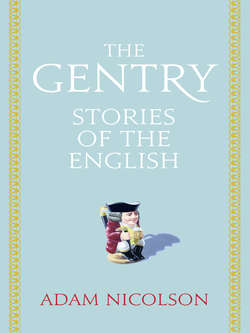Читать книгу The Gentry: Stories of the English - Adam Nicolson - Страница 11
ОглавлениеThe Tudors were the most successful gentry family in English history. Owen Tudor, an obscure and impoverished North Wales squire, working as a servant in the royal household, managed in about 1428 to catch the eye of Henry V’s widow, Catherine of Valois, a few years after her warrior husband had died. It is not quite certain how he did it but Owen either fell into her lap when dancing drunk or went swimming in front of her and her ladies. It was a Mr Darcy moment. One chronicler, who knew Catherine well, said she was ‘unable fully to curb her carnal passions’1 when confronted with the magnificent sight of Tudor in the water – she was about twenty-five, he a year to two older – and English history changed. Their sons became power-players in the Wars of the Roses and from that long violent crisis their grandson Henry Tudor emerged the victor at Bosworth Field in 1485. On 30 October that year he was crowned King of England as Henry VII. In this way, the smallest of vicissitudes can change whole worlds.
The civil wars of the fifteenth century which had brought the Tudors to power had destroyed the world of the great medieval magnates. Under the Tudors, overwhelmingly aware of the vulnerability of a crown weaker than its greatest subjects, the great magnates were excluded from influence. After the 1530s, and Henry VIII’s raid on church property and independent power, the church went too. That should have left the crown itself dominating the field, buttressed by the imposing and often terrifying authority of the Tudor state, but in an era before comprehensive taxation, the crown was chronically underfunded, inherently extravagant and forced to spend capital as income. Between the 1530s and the 1630s, it lost what it should have gained.
Statistics can only be the roughest of informed guesses. Nevertheless, through the sixteenth and seventeenth centuries there is no doubt that the economic and social structures of England underwent the deepest of transformations and the great beneficiaries of this double revolution – the failure of the magnates and then the failure of the crown – were the gentry. Their landholding rose from 20 per cent in the Middle Ages to something like half the country by the middle of the seventeenth century. The result was that where the crown, the church and the great lords had ruled medieval England, the great lords and the gentry came to rule early modern England.
This is the fluid and difficult environment in which the Throckmortons found themselves in the 1530s and where the Thynnes rode to riches and significance. Any number of sixteenth-century ‘new men’ understood the lesson promulgated by the old and cynical Tudor statesman William Paulet, Marquess of Winchester. When asked at the end of his career how he had managed to survive for thirty years at the centre of power, through so many reigns and changes, he said, ‘Ortus sum ex salice, non ex quercu, I was made of the plyable Willow, not of the stubborn Oak.’2 The heart of survival: pliancy.
It would be a mistake to make the focus of this history only the pain and struggle of survival in a challenging world. Tudor England was beautiful. Nowhere else in Europe was as green as England and every foreign visitor remarked on it – the thickness of the overhanging trees, the day-long spread of pasture as you rode across country. It was a world of beef and sheep. To keep the fertility up, advisers on Tudor agriculture recommended sowing the meadows with a mixture of clovers, yarrow, tormentil and English plantain. The ‘whole country is well wooded and shady’, a Frenchman, Estienne Perlin, wrote in 1558, ‘for the fields are all enclosed with hedges, oak trees and several other sorts of trees, to such an extent that in travelling you think you are in a continuous wood’.3 English pigs amazed strangers with their size and fatness. The best chickens Polydore Vergil ever ate came from Kent. The horses were strong and handsome and were exported abroad. It was a thickened country, dense with locality. This was the wild thyme, oxlip and honeysuckle landscape that would form the remembered and dreamed-of background to a century of violent political and religious change. That is the definition of sixteenth-century England: government bordering on tyranny in a country filled with sweet musk roses and eglantine.
The sixteenth century was a time to be in land. The weather was improving and more children were surviving into adulthood. The number of people in England was rising faster than the amount of food that could be grown for them. With a mismatch of supply and demand, food prices rose, tripling between 1508 and 1551, and rents rose with them. Agricultural land in the sixteenth century was the most reliable source of cash there was. But the ability to deliver the increased yields depended on returning fertility to the ground. A mixed country, in which there was plenty of grazing, much of it already enclosed, was a recipe for financial success. Meadows were money in Tudor England and both these families were blessed with them. Much of the story that follows here – of ideological courage and daring in the face of power; of families squabbling to get their hands on an inheritance – would not have been possible without that pasture-rich background. Tudor gentry floated on grass.
